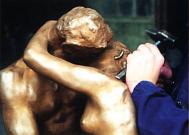|
  Documenting the shrinking process during casting: Documenting the shrinking process during casting:
Still
another application can be found in the geometrical comparison of a
plaster cast with a bronze cast deducted from this plaster shape. An exact
morphological analysis allows for determining the exact quantity of metal
shrinking and can point out formal deformations due to irregular shrinking
or unprofessional chiselling.
 Qualitative/quantitative comparison of competing casting
methods: Qualitative/quantitative comparison of competing casting
methods:
It would be possible to compare the results of lost wax
and sand casting - two casting methods that already competed during
Rodin's life-time . .
 Visualise deformations due to enlargement and reduction of
sculptures: Visualise deformations due to enlargement and reduction of
sculptures:
From ca. 1900 on, Rodin had his collaborator
Henri LeBossé produce a series of enlargements and reductions, in order
to satisfy the differentiated needs of collectors and institutions. These
translations were made by means of a Collas Machine and then corrected
under the personal supervision of the artist. Since virtual models
can be variably scaled, it would be possible to determine the exact effect
of this process with regard to formal trueness.
 Comparing initial model and final execution: Comparing initial model and final execution:
By the
same methods, it is possible to compare the first draft of a sculpture
with the later, final execution and visualise the adaptions and
corrections made the sculptor in their exact quantitative amount.
 Compare the execution of marble sculptures by different praticiens: Compare the execution of marble sculptures by different praticiens:
Rodin
had his marble sculptures executed by talented young sculptors, who
sometimes left their own impress of style in the final work (for example
Jean Escoula, Bust of Mme Vicuna). By comparing different marbles executed
by different praticiens, it would be possible to determine how much
of their own "handwriting" these praticiens realised in their
respective executions.
|